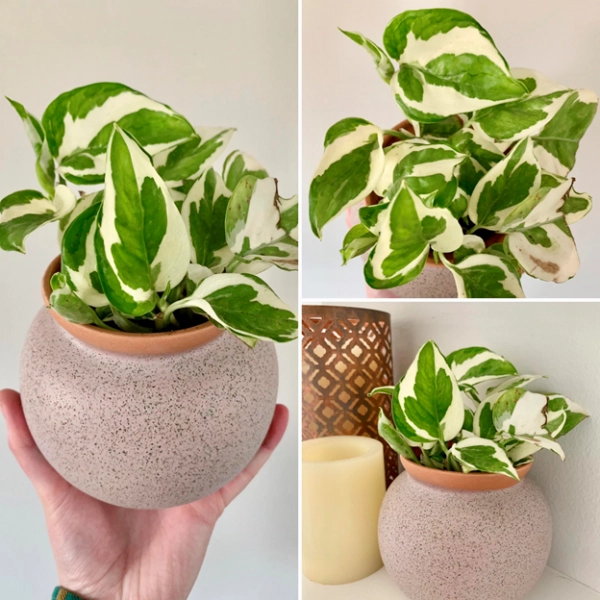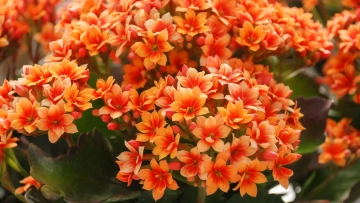Why Pothos is the Perfect Plant for Natural Air Purification?
Pothos (Epipremnum aureum) is one of the top indoor plants known for its air-purifying capabilities. NASA’s research shows that Pothos not only enhances air quality but also absorbs harmful substances like cigarette smoke, benzene, and formaldehyde—common toxins released from industrial furniture. This makes Pothos a popular choice for decorating workspaces and indoor environments.

Pothos is a tropical climbing plant native to the Solomon Islands in the South Pacific. It is not only easy to care for but also grows rapidly, whether climbing up supports or trailing down from pots or hanging baskets. With its adaptability and low maintenance, Pothos is an ideal choice for both beginners and those who enjoy adding greenery to their interiors. However, it's important to note that Pothos is toxic to pets.
Types of Pothos Plants
There are many varieties of Pothos available, which can be differentiated by the color, shape, and appearance of their leaves and stems. Below are some of the popular varieties.
1. Golden Pothos
Golden Pothos is the traditional and most common variety, distinguished by heart-shaped leaves in a vibrant blend of green and yellow. The stem is also green, matching the leaves. Under optimal conditions, such as adequate sunlight, warm temperatures, and proper watering and nutrition, the leaves can grow quite large, sometimes reaching up to 30 cm (12 inches) in width.

Golden Pothos is highly effective at removing toxins such as benzene, formaldehyde, trichloroethylene, toluene, and xylene from the air. It is one of the 17 most effective air-purifying plants identified by NASA in their 1989 study.
2. Marble Queen Pothos
The Marble Queen Pothos has heart-shaped leaves that are slightly more elongated than those of the Golden Pothos. Its foliage features a mix of green and creamy white, with the creamy white being more dominant.

This variety, like the Golden Pothos, grows well with proper care and is known for its vigorous growth.
3. Jessenia Pothos
Jessenia Pothos has leaves similar to Marble Queen Pothos, but upon closer inspection, the green is more prominent, and the cream color is more of a yellowish-white. The stem matches the green of the leaves.

This variety grows more slowly than the Golden Pothos and does not display the same vibrant coloration.
4. Manjula Pothos
Manjula Pothos stands out with its wavy-edged leaves, unlike the flat leaves of other Pothos varieties. The foliage exhibits a beautiful range of shades from silver, white, and cream to light and dark green. The stems are often white or silver.

5. Pearl and Jade Pothos
The leaves of Pearl and Jade Pothos are a mix of jade green and creamy white, with silvery gray and wavy edges similar to Manjula Pothos. Its leaves feature patches of white interspersed with green and silver tones.
While this variety has stunning leaf colors, it is also the most challenging to care for. Pearl and Jade Pothos cannot tolerate direct sunlight; too much sun can cause the leaves to dry out and the plant to die quickly without recovery.

It is also a very slow grower, with the smallest leaves and a tendency not to vine as much as other varieties. The leaves are as thin as tissue paper, making them prone to burning.
6. Silver Pothos
Silver Pothos has thicker, sturdier leaves compared to other Pothos varieties. Its heart-shaped leaves are small, edged with silver, and have dark green surfaces speckled with small silver spots. The underside of the leaves is a lighter green without the silver speckling seen on the top surface, unlike other Pothos varieties where both sides of the leaves are the same color. The stem is also the thickest among the Pothos varieties and does not tend to vine much.

7. Neon Pothos
Neon Pothos has elongated leaves, though they occasionally maintain a heart shape. Its vibrant, neon-like color makes it stand out among Pothos varieties.

This variety is particularly unique as it retains its bright color throughout the year and grows well even in shaded areas. It can also thrive in water or semi-hydroponic setups with minimal care, requiring only occasional water refills.
8. Cebu Blue Pothos
Among the Pothos varieties, Cebu Blue Pothos is unique for its long, arrow-shaped leaves. It features a single, glossy shade of green, with older or dusty leaves becoming more matte. The stem matches the green of the leaves.

This variety is drought-tolerant and grows vigorously.
Guide to Caring for Pothos Plants
Pothos is not only easy to care for but also adds a refreshing touch of greenery to living spaces. However, when dealing with young plants, there are some important things to keep in mind to ensure strong and healthy growth.
Light
- Outdoors: Place the plant in shaded areas such as balconies or under tree canopies to avoid direct sunlight. Young plants need time to develop their root systems, much like infants needing protection from harsh conditions such as intense sunlight and high temperatures.
- Indoors: If growing Pothos indoors without natural light, you can place the plant on a desk or table and provide artificial light from desk lamps or reading lights to aid in the plant's photosynthesis process.
Soil
Pothos thrives best in well-draining, aerated potting soil. The soil should have a pH between 6.1 and 6.8, which is slightly acidic or neutral. Choose soil that retains moisture moderately but does not cause waterlogging.
Watering
Water the plant once every 1 to 2 weeks, depending on the weather conditions. During the growing season, water more frequently, while in winter, reduce watering. Allow the soil to dry out completely between waterings to prevent root rot. Signs of overwatering include black spots on the leaves or a wilted appearance. Pothos will show drooping leaves when it needs water, but don't wait until the leaves wilt completely, as this can cause the plant to shed its leaves.
If the leaf edges turn brown and dry, the plant may have been underwatered for too long. Therefore, maintain a consistent watering routine.
Fertilizing
Pothos doesn't require frequent fertilizing, but feeding it during the growing season will encourage better growth. Apply a balanced fertilizer once a month during spring and summer. Avoid fertilizing during winter when the plant is dormant.
Pro Tip: When growing Pothos indoors, place a plastic pot on a saucer to catch any water and soil spills during watering.
Care Tips for Pothos Plants
As the plant grows, some leaves may weaken and fail to develop new roots, eventually turning yellow and wilting. This is normal during propagation, with success rates typically ranging from 80-90%.
- After 15-20 days: If new leaf buds start to appear, this indicates the roots have adapted to the soil environment and the plant is stabilizing.
- After 30 days: You will notice significant growth, and the plant will now be strong enough to live like a regular potted plant. Light and humidity conditions will no longer need to be as strict, and you can place the plant anywhere, and it will continue to grow.
- After 5-6 months: The plant will be mature enough for you to cut and propagate, creating new baby plants from the mother plant.
Planting and Repotting Guide for Pothos
Over time, your Pothos plant will grow vigorously, which can cause the roots to become root-bound in the pot. If you notice the leaves drooping even after regular watering, or if you see roots growing out of the drainage holes at the bottom of the pot, it's a sign that the plant needs to be repotted. To check further, gently lift the plant from the pot to inspect the root condition.
When the plant reaches this stage, repot it into a larger pot, one or two sizes bigger, allowing the roots more space to grow. Make sure to use fresh, loose, and well-draining potting soil to help the plant recover easily. Water thoroughly after repotting to help the plant adjust to its new environment. The ideal time to repot is during the growing season, typically in spring or early summer. Choose pots made of plastic, ceramic, metal, or terracotta, with a preference for good drainage. If you're growing the plant in low-light conditions, terracotta is a good choice due to its excellent moisture-wicking properties.
With its soft, trailing vines, Pothos is well-suited for hanging baskets or macrame planters. You can also grow Pothos in water, as long as the pot has no drainage holes and is waterproof.
Common Pests and Diseases in Pothos
Although Pothos is generally easy to care for and resistant to pests, it can still face some common issues when grown indoors. Here are a few pests and how to deal with them:
- Spider Mites: These tiny mites can create webs on the leaves and stems, causing tiny specks on the foliage. Wipe the leaves clean with a damp cloth and spray horticultural oil or neem oil to control the infestation.
- Whiteflies: These tiny, heart-shaped flies scatter when the plant is disturbed. Use insecticidal soap or sticky traps to get rid of whiteflies.
- Scale: These small, shell-like clusters attach to stems or leaves. Use a cotton swab dipped in alcohol to clean them off, or trim away affected areas.
- Mealybugs: Mealybugs are identified by their oval, white waxy coating on stems. Spray the plant with water or neem oil to eliminate them.
Common Problems with Pothos
- Yellow Leaves: Occasional yellow leaves are not a major concern if the plant continues to produce new ones. However, sudden widespread yellowing may indicate root rot or a bacterial/fungal infection caused by overwatering.
- Brown Leaves: Brown leaves may result from insufficient light, overwatering, or low humidity. If the leaves are dry and brittle, the plant may be underwatered or experiencing low humidity.
- Drooping Leaves: Drooping or wilting leaves indicate the plant is stressed, often due to underwatering. Ensure the plant is adequately watered and monitor soil moisture. This issue can also occur if the roots are pot-bound or if the plant is facing health problems.
Pothos is not only easy to care for but can adapt to various environments, from soil to water. However, monitoring the roots, leaves, and providing proper care will keep the plant lush and growing vigorously.
Tags: Indoor Ornamental Plants | Outdoor Ornamental Plants | Bonsai Plants | Aquatic Ornamental Plants | Miniature Ornamental Plants |
























LEAVE A REPLY
Your email address will not be published. Required fields are marked *